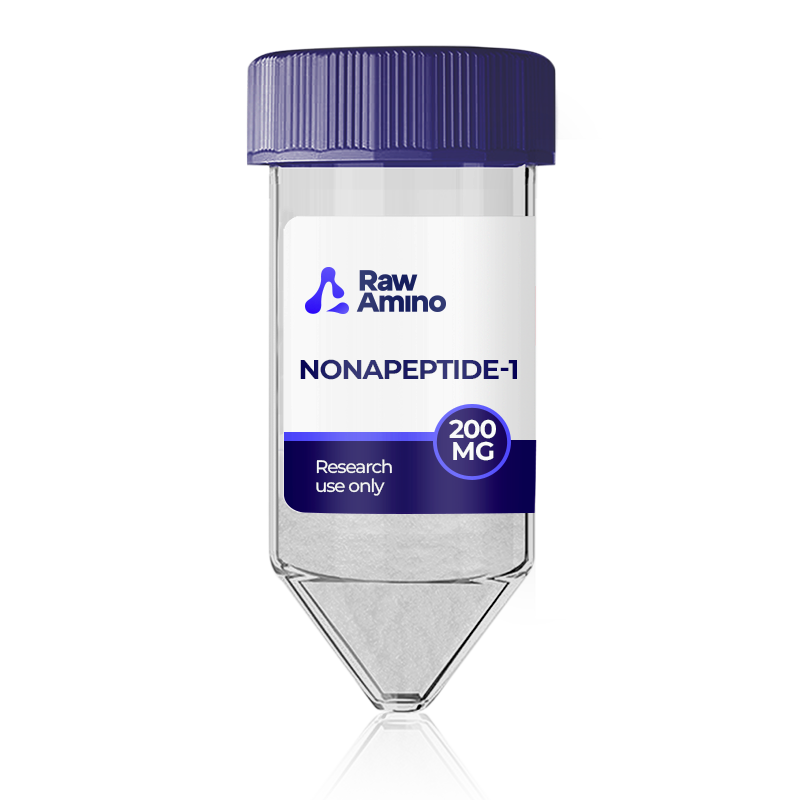
Nonapeptide-1 – 200MG
$212.00
Discount per Quantity
| Quantity | Discount | Price |
|---|---|---|
| 5 - 8 | 5% | $201.40 |
| 9 + | 10% | $190.80 |
Scientific Overview of Nonapeptide-1
Nonapeptide-1, also referred to as Melanostatine-5, is a synthetic peptide studied for its potential influence on pigment regulation within melanocytes, the specialized cells responsible for producing melanin. This compound emerged from peptide library screenings that investigated thousands of variations, with Nonapeptide-1 appearing as one of the most potent inhibitors of melanocortin-1 receptor (MC1R) activity. MC1R is a receptor central to pigment production processes, and its inhibition by this peptide has been proposed to modulate melanin synthesis. Structural considerations suggest that certain amino acids, including D-Trp at position 5 and Phe at position 6, may be key contributors to its antagonistic potential. Because of its potential to alter pathways underlying pigmentation, Nonapeptide-1 has drawn scientific attention in research models examining pigmentation control and melanin-related conditions.
Alternative Names: Melanostatine, Melanostatine-5, Oxytocin Intermediate-nine peptide
Nonapeptide-1 Studies and Research Data
Nonapeptide-1 Interactions With Cellular Signaling
Scientific investigations propose that Nonapeptide-1 may interfere with MC1R by competing with alpha-melanocyte-stimulating hormone (α-MSH). This interaction could prevent the cascade typically initiated by α-MSH binding, which otherwise activates enzymes such as tyrosinase and increases melanin formation. Laboratory studies with keratinocyte and melanocyte cell lines exposed to ultraviolet light suggest that Nonapeptide-1 may reduce both MC1R expression and the levels of related proteins including TRP1, TRP2, and MITF. Such changes appear to lower the responsiveness of melanocytes to pigmentation stimuli, providing insight into how melanin production might be regulated in experimental contexts.
Pigmentation Research in Experimental Models
Investigations in controlled models of pigmentation have suggested that Nonapeptide-1 may reduce melanin synthesis and overall pigmentation levels. In experimental melasma studies, researchers reported measurable decreases in pigmentation indices and severity scores when compared with controls. These findings have been drawn from structured pilot studies, where outcomes indicated a potential shift in pigmentation dynamics over extended observation periods. While early results suggest promise in altering pigmentation pathways, the interpretation remains exploratory and limited to laboratory research contexts.
Receptor Roles in Tumor Biology
MC1R has been studied not only in pigmentation but also in tumor biology, particularly in melanoma models. Research exploring receptor inhibition in melanoma cell lines has suggested slower proliferation and reduced heterogeneity of tumor cells when MC1R is suppressed. Although Nonapeptide-1 itself has not been extensively tested in this domain, parallels may exist between receptor-targeting strategies that highlight MC1R as a molecular feature of interest in tumor cell growth and morphology research.
Nonapeptide-1 Links to Neurotransmitter Pathways
Emerging research proposes that MC1R may also have roles in the central nervous system. Investigations in murine models indicate that modulation of MC1R antagonists could influence nociception and responses to painful stimuli. Nonapeptide-1, by functioning as an MC1R antagonist, might exhibit comparable potential interactions. For example, animal studies with overexpressed endogenous MC1R antagonists suggested decreased inflammatory responses and altered behavioral responses to noxious agents such as capsaicin. Although Nonapeptide-1 itself has not been directly tested in these neurological contexts, its receptor interactions provide grounds for scientific curiosity regarding its possible influence on neurotransmitter-related mechanisms.
Conclusion
Nonapeptide-1 has been explored primarily for its potential role in modulating pigmentation pathways by influencing MC1R activity. Research has also extended into possible roles in tumor biology and neurological systems, though findings remain preliminary and require further investigation. The compound stands out as a laboratory tool that may help researchers better understand receptor-linked processes in pigmentation, cellular growth, and nociception.
References
- Puciłowski O, Płaźnik A, Kostowski W. Melanostatyna (MIF-1): działania ośrodkowe i próby kliniczne [Melanostatin (MIF-1): central action and clinical use]. Pol Tyg Lek. 1983 Jun 13;38(24):739-41. Polish. PMID: 6139794.
- Delaney, A., Keighren, M., Fleetwood-Walker, S. M., & Jackson, I. J. (2010). Involvement of the melanocortin-1 receptor in acute pain and pain of inflammatory but not neuropathic origin. PloS one, 5(9), e12498. https://doi.org/10.1371/journal.pone.0012498
- Mohammed, Y. H., Moghimi, H. R., Yousef, S. A., Chandrasekaran, N. C., Bibi, C. R., Sukumar, S. C., Grice, J. E., Sakran, W., & Roberts, M. S. (2017). Efficacy, Safety and Targets in Topical and Transdermal Active and Excipient Delivery. Percutaneous Penetration Enhancers Drug Penetration Into/Through the Skin: Methodology and General Considerations, 369–391. https://doi.org/10.1007/978-3-662-53270-6_23
- Jayawickreme, C. K., Quillan, J. M., Graminski, G. F., & Lerner, M. R. (1994). Discovery and structure-function analysis of alpha-melanocyte-stimulating hormone antagonists. Journal of Biological Chemistry, 269(47), 29846-29854.
- Chatterjee, M., Neema, S., & Rajput, G. R. (2021). A randomized controlled pilot study of a proprietary combination versus sunscreen in melasma maintenance. Indian journal of dermatology, venereology and leprology, 88(1), 51–58. https://doi.org/10.25259/IJDVL_976_18
- Xia, Y., Wikberg, J. E., & Chhajlani, V. (1995). Expression of melanocortin 1 receptor in periaqueductal gray matter. Neuroreport, 6(16), 2193-2196.
- Boo YC. Up- or Downregulation of Melanin Synthesis Using Amino Acids, Peptides, and Their Analogs. Biomedicines. 2020 Sep 1;8(9):322. doi: 10.3390/biomedicines8090322. PMID: 32882959; PMCID: PMC7555855.
- Kansal, R. G., McCravy, M. S., Basham, J. H., Earl, J. A., McMurray, S. L., Starner, C. J., Whitt, M. A., & Albritton, L. M. (2016). Inhibition of melanocortin 1 receptor slows melanoma growth, reduces tumor heterogeneity and increases survival. Oncotarget, 7(18), 26331–26345. https://doi.org/10.18632/oncotarget.8372
Disclaimer:
The products mentioned are intended solely for laboratory research and in-vitro experimentation. They are not approved for human or animal use of any kind. All details provided are for educational purposes only. By purchasing from this site, you agree to comply with our Terms and Conditions.
Only logged in customers may leave a review.
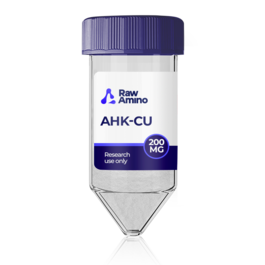

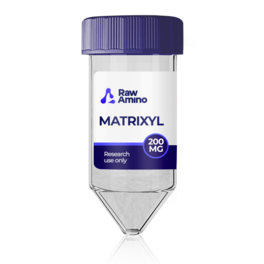
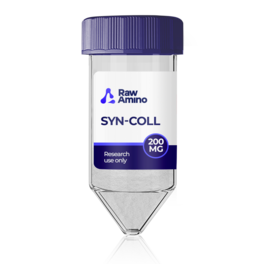
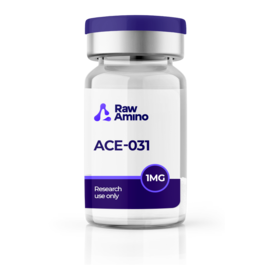
Reviews
There are no reviews yet.